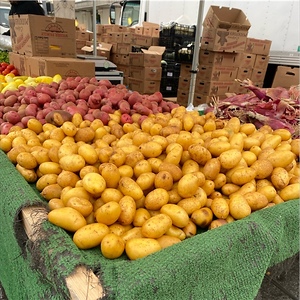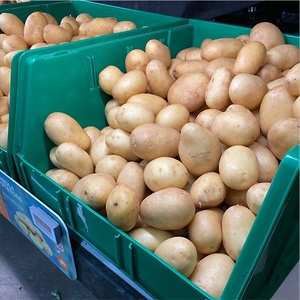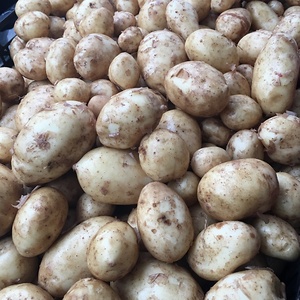


Carola Potatoes
Estimated Inventory, lb : 0
Description/Taste
Carola potatoes are medium-sized spuds with a round, ovate form that may be slightly irregularly shaped. They have smooth skin that ranges in color from yellow to pale tan and is dotted with brown freckles, creating the appearance of dirt spots. This thin skin can be peeled to reveal the potato’s firm, creamy yellow flesh. This flesh is dense, waxy, and moist with a relatively low starch content. When cooked, Carola potatoes have a buttery, earthy, and nutty sweetness with a smooth, fluffy, and fine-grained texture.
Seasons/Availability
Carola potatoes are available in the late summer through fall.
Current Facts
Carola potatoes are botanically classified as Solanum tuberosum and are members of the Solanaceae, or nightshade, family. This family includes eggplants, chili peppers, potatoes, and tomatillos. Carola potatoes are believed to be a German hybrid of Weima and Ober Arnbacher Frühe potatoes. German potato varieties may be categorized as festkochend, or waxy potatoes, mehlig kochend, or starchy potatoes, and vorwiegend festkochend, all-purpose potatoes. Carola would fall under the festkochend category because of their waxy flesh. Experiencing a brief period of popularity in the 1980s in Europe, Carola potatoes have struggled to reach worldwide acclaim partially due to the existence of Yukon Gold potatoes. Yukon Gold produces a higher yield, playing a significant role in the commercial success of this variety over Carola potatoes. Despite this, Carola potatoes remain valued for their culinary qualities and are commonly used in hearty German recipes.
Nutritional Value
Carola potatoes have a high vitamin C content that helps boost immune function, supports healthy skin, and aids in wound healing. Fiber in Carola potatoes promotes digestion by encouraging regular bowel movements and maintaining gut health. The potassium in these potatoes helps regulate blood pressure, while its iron content supports healthy blood circulation and energy levels. The calcium in this variety contributes to strong bones and teeth, helping prevent conditions like osteoporosis. Additionally, Carola potatoes contain carotenoids, plant compounds that support eye health. Their antioxidants help protect the body from oxidative stress and reduce inflammation.
Applications
Carola potatoes are best suited for grilling, roasting, baking, mashing, boiling, and steaming, and should not be eaten raw. Their firm texture makes them ideal for a potato salad with mustard, vinegar, onions, and fresh herbs. This variety may also be used to make fries, potato hash, hashbrowns, gratins, and small baked potatoes. Carola potatoes' creamy yet firm texture fairs well in soups like clam chowder, potato leek, chicken noodle, and minestrone. They may be sliced into thin rounds that bode well for casseroles or scalloped potatoes. Their buttery taste pairs with red onion, tomato, radish, asparagus, Brussels sprouts, thyme, parsley, chives, blue cheese, sour cream, bacon, chicken liver, sea salt, and hardboiled eggs. They will keep up to a month when stored in a cool, dry, and dark place.
Ethnic/Cultural Info
Potatoes have played a significant role in German culture and history, initially through the efforts of royalty. They were planted in the royal garden of Oranienburg near Berlin, which was created in an ornamental Baroque fashion for the Brandenburg-Prussian court. Frederick the Great of Prussia recognized the crop's value, especially during wartime when grain supplies were vulnerable. He encouraged the widespread adoption of potatoes to prevent famine, even employing creative methods to make them more appealing to the public. His efforts culminated in the Potato War, where soldiers foraged for potatoes more than they fought.
Geography/History
Carola potatoes are native to Germany where they were created by Walter Wallmüller of Saatzuchtwirtschaft and released to the market in 1979. They're believed to have made their way to the United States through immigrants who arrived in New York and the Midwest. They experienced a brief stint of popularity in Germany and Great Britain in the 1980s but were then discontinued in 1989. In 1999, an improved variety was released in Europe under the same name, but had a slightly different shape and superior disease resistance. They have a small, growing market in the United States where they are sold as specialty potatoes and are most commonly cultivated in home gardens and on small farms. Today, the best place to find the Carola potato outside of a seed catalog is a local farmers market or specialty grocer in the United States or Europe.
Recipe Ideas
Recipes that include Carola Potatoes. One
| Oh My Veggies |
|
Slow Cooker Rosemary Garlic Mashed Potatoes |
| Tigers and Strawberries |
|
Indian Style Carola Potatoes |










